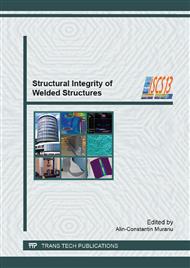p.49
p.54
p.60
p.68
p.76
p.82
p.87
p.99
p.104
The Comparative Analysis of the Concentration of Microparticles during Mechanized MAG Welding Using Cored Wires
Abstract:
Use of cored wire - shielding gas (gas mixture) pair, during mechanized MAG welding, causes the microparticles formation which is harmful for the welder’s health. The paper presents the experimental method for determining the concentration of the microparticles generated during MAG welding when rutile cored wires (standard and low fume emission) and metal powder cored wires (standard and low fume emission) are used. Carbon dioxide and the shielding gas mixture are investigated, too. Four types of cored wires were comparatively analysed, when three wire speed values were applied. The research of the microparticles concentration was conducted after each welding bead deposition, at the upper part of the welding enclosure, using MicroDust Pro particulate monitor. After each weld bead was deposited, the metal frame of the welding enclosure was removed, and, the fumes and gases, produced during the welding process, were eliminated through two fans, positioned inside and outside of the equipment. Using rutile cored wire with low fume emission, a decrease of microparticles concentration up to 30% is noticed in comparison with standard rutile cored wire. Using metal powders cored wire with low fume emission, the microparticles concentration is diminished with 12.5% comparing with standard metal powders cored wire.
Info:
Periodical:
Pages:
76-81
Citation:
Online since:
September 2013
Keywords:
Price:
Сopyright:
© 2013 Trans Tech Publications Ltd. All Rights Reserved
Share:
Citation:


